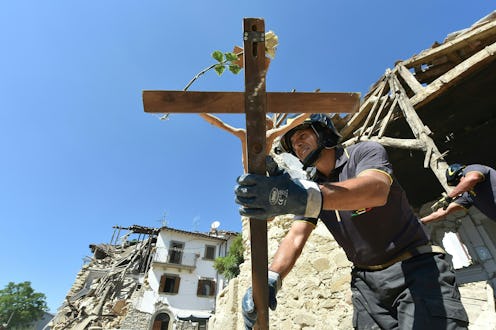News
How Italian Museums Are Cleaning Up The Country
Since Wednesday, Italian cities north of Rome have been digging themselves out of seemingly endless piles of debris and rubble, after a devastating 6.2-magnitude earthquake rocked the boot-shaped country. The clean-up work is made more difficult by crumbling infrastructure and violent aftershocks, but the search for survivors remains a top priority. As the work continues, Italy's museums are supporting the earthquake relief efforts, donating their proceeds to reconstruction efforts.
Italian Culture Minister Dario Franceschini announced that proceeds from Sunday's admission fees at state-run museums would go toward rebuilding efforts. The move is a poignant reminder of the historic artifacts and relics that may be lost forever as a result of the destruction. According to NPR, the initiative by Italy's museums gives people in the country an opportunity to explore Italy's rich history while helping to preserve what important pieces of Italian culture can be salvaged in the earthquake-stricken cities.
Nearly 300 people have died as a result of the quake, and officials have acknowledged that the search for survivors grows grimmer with each day. As of Sunday, the initial quake had occurred five days prior, and aftershocks have only made the rubble a more dangerous place to search and to survive in. The death toll could continue to rise as clean-up crews are able to clear more of the debris.
In addition to the casualties, officials worry about the effects of the earthquake on Italy's culture. According to the BBC, Franceschini has said that 293 culturally important sites in the affected area have been damaged or destroyed. Many of those sites are churches, and Franceschini hopes to recover some of the structures or fragments of structures that have been destroyed.
It doesn't help that the earthquake struck a collection of historic towns the hardest. For instance, Amatrice is a small town in central Italy that dates back to medieval times. As such, many of its churches and other buildings were several hundred — if not a thousand — years old. Now, many of those buildings have been destroyed by the quake. Amatrice alone lost at least 229 residents in the natural disaster.
As the BBC reported, historic towns like Amatrice may not have been well-equipped to handle the quake. After all, many of their buildings pre-date the modern building codes, which often require earthquake-proofing. Historic towns, then, don't have to abide by the anti-quake regulations, and even many of the newly constructed buildings may not have been built to withstand such a force.
What can be salvaged from Amatrice and the other historic cities may someday find its way to one of Italy's state-run museums. There, it could serve as a reminder of the country's rich history and the modern-day disaster. But first, it will all have to be cleaned up — and that's where the museum donations come in.
